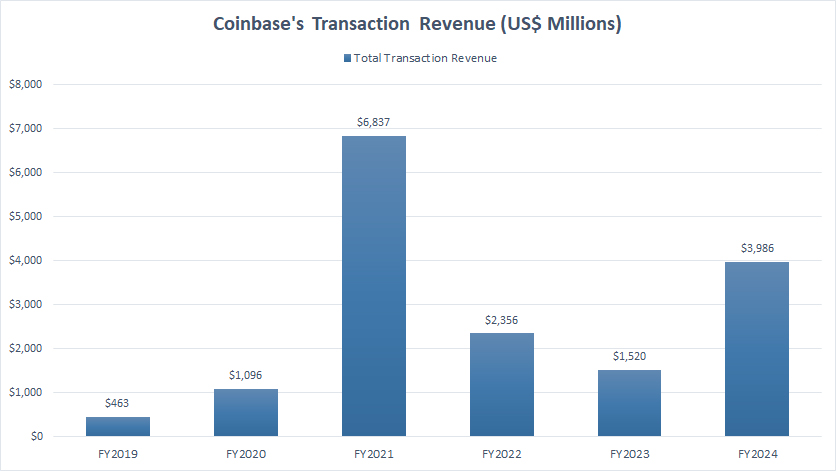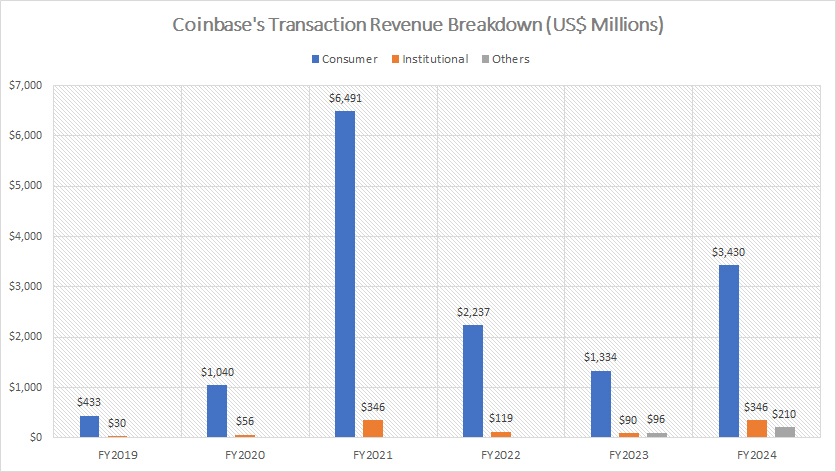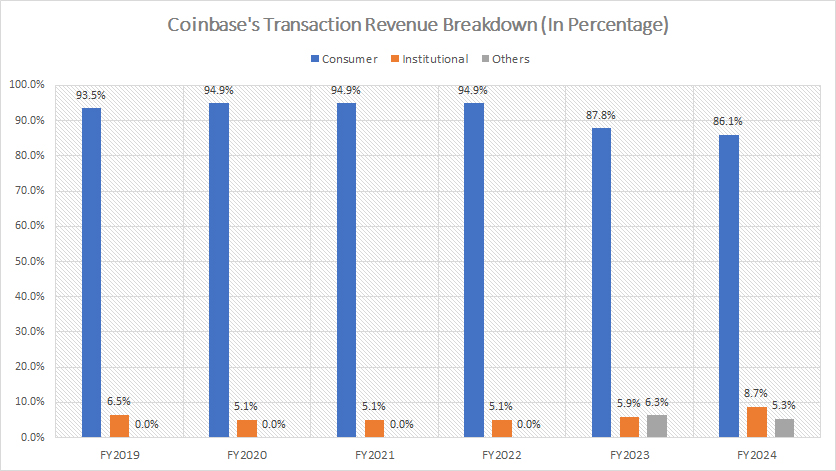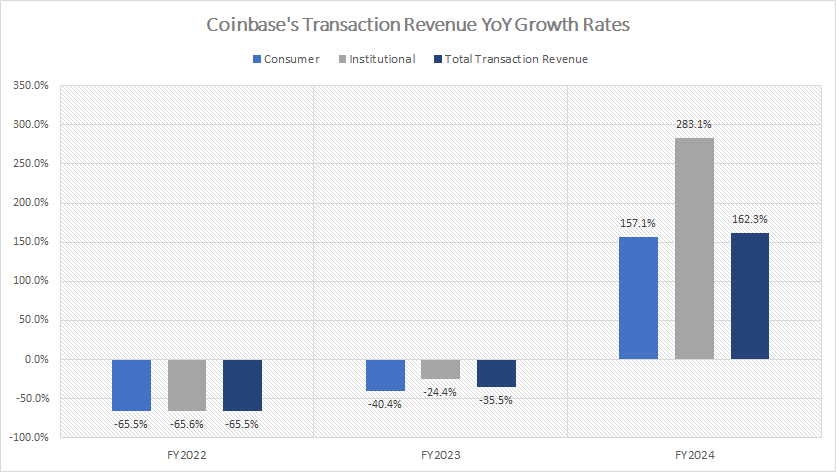
Crypto transaction. Pexels image.
This article presents the breakdown of Coinbase Global, Inc. (NASDAQ: COIN)’s transaction revenue. Coinbase’s transaction revenue primarily comes from fees charged on cryptocurrency trades conducted on its platform.
These fees are applied to both buying and selling transactions and vary depending on factors like the transaction amount, payment method, and user type (e.g., retail or institutional).
You can find more information about Coinbase’s transaction revenue streams here: consumer and institutional.
For transaction revenue based on cryptocurrency such as Bitcoin and Ethereum, you may find refer to this article: Coinbase trading revenue by crypto asset.
For other key statistics of Coinbase Global, you may find more resources on these pages:
- Coinbase revenue by country: U.S. and International,
- Coinbase employee worldwide, revenue and profit per employee, and
- Coinbase subscription and services revenue breakdown analysis.
Please use the table of contents to navigate this page.
Table Of Contents
Definitions And Overview
O2. Why is Coinbase’s transaction revenue soaring?
Consolidated Results
A1. Transaction Revenue
A2. Percentage Of Transaction Revenue To Total
Revenue Breakdown
B1. Revenue From Consumer and Institutional
B2. Percentage Of Revenue From Consumer and Institutional
Revenue Growth
C1. YoY Growth Rates Of Revenue From Consumer and Institutional
Conclusion And Reference
S1. Insight
S2. References and Credits
S3. Disclosure
Definitions
To help readers understand the content better, the following terms and glossaries have been provided.
Consumer: Coinbase’s transaction revenue from the Consumer segment is derived from fees charged to individual retail users for cryptocurrency transactions.
These fees are applied to buying, selling, and converting cryptocurrencies on the platform. The Consumer segment represents a significant portion of Coinbase’s overall transaction revenue, as it caters to a large base of individual users engaging in crypto trading.
Institutional: Coinbase’s transaction revenue from the Institutional segment comes from fees charged to institutional clients for cryptocurrency trading and related services.
This includes transactions executed through Coinbase Prime, which is tailored for institutional investors, offering advanced trading features, dedicated account management, and access to liquidity solutions.
Why is Coinbase’s transaction revenue soaring?
Coinbase’s transaction revenue is soaring due to several key factors:
-
Bitcoin Spot ETFs Driving Institutional and Retail Interest:
- The approval of Bitcoin spot ETFs has created a surge in cryptocurrency trading activity. Spot ETFs are appealing to institutional investors as they provide exposure to Bitcoin without the complexities of owning it directly. This has not only increased trading volumes but also attracted a broader demographic of traders, boosting transaction fees.
-
Base Layer 2 Blockchain Success:
- Coinbase launched Base, a Layer 2 scaling solution, to enhance blockchain efficiency and reduce transaction costs. Base has attracted significant activity in decentralized finance (DeFi) and gaming applications.
-
Institutional Growth Through Custodial Services:
- Acting as a custodian for multiple Bitcoin ETFs, Coinbase has deepened its relationships with institutional clients. These partnerships, alongside its advanced Coinbase Prime platform, have solidified its role as a top choice for institutional cryptocurrency trading, generating robust transaction revenues.
-
Market Momentum and Price Recovery:
- The rally in cryptocurrency prices, led by Bitcoin and Ethereum, has sparked renewed interest from retail traders and institutional players alike. Higher crypto valuations often lead to greater trading activity as investors aim to capitalize on market movements, thus driving up transaction volumes and revenue.
-
Expanding Global Operations:
- Coinbase’s international expansion strategy, including entry into Canada, Brazil, and other key markets, has allowed it to tap into previously underpenetrated regions. This diversification has contributed to both consumer and institutional transaction revenue growth.
-
Retail Engagement and Fee Structures:
- Coinbase’s Consumer segment, which applies variable transaction fees based on trade size and payment methods, remains a dominant revenue driver. Growth in retail user adoption, spurred by market optimism and an expanding range of supported cryptocurrencies, amplifies its revenue streams.
-
Innovation and Diversified Revenue Sources:
- Beyond simple transaction fees, Coinbase has been innovative in leveraging its ecosystem, integrating features like staking, subscription services (Coinbase One), and advanced trading tools, creating additional incentives for user engagement and increasing overall trading activity.
The interplay between strategic innovation, market dynamics, and successful global expansion has positioned Coinbase to capture immense value from the current cryptocurrency market landscape.
Transaction Revenue
coinbase-transaction-revenue
(click image to expand)
On a consolidated basis, Coinbase achieved transaction revenue totaling $4.0 billion in fiscal year 2024, representing a remarkable 162% increase compared to the $1.5 billion reported in fiscal year 2023.
This significant growth underscores Coinbase’s success in capitalizing on favorable market conditions, including increased cryptocurrency trading activity and the adoption of innovative products like its Layer 2 blockchain solution, Base.
Notably, this revenue surge marks a pivotal turnaround after two consecutive years of declining transaction revenue in fiscal years 2022 and 2021. The rebound highlights Coinbase’s ability to adapt to the evolving cryptocurrency landscape, attract new retail and institutional users, and drive increased trading volumes.
Strategic initiatives like global expansion and partnerships with traditional finance firms have further enhanced Coinbase’s market position and contributed to its impressive financial performance.
This exceptional growth trajectory sets a promising foundation for Coinbase as it continues to navigate the dynamic crypto ecosystem and explore opportunities to sustain and expand its transaction revenue streams in the coming years.
Percentage Of Transaction Revenue To Total
coinbase-transaction-revenue-to-total-revenue-ratio
(click image to expand)
In fiscal year 2024, Coinbase’s transaction revenue made up 61% of its total revenue, marking a substantial increase from 49% in 2023. This rebound highlights the renewed strength of its core trading activities following a period of diminishing contributions from this segment.
However, over a broader timeline, the share of transaction revenue as a percentage of total revenue has seen a marked decline. From fiscal year 2018 to 2021, transaction revenue consistently accounted for over 80% of Coinbase’s overall earnings, reflecting its dominance as a primary revenue driver.
This proportion dropped to 74% in fiscal year 2022, signaling a gradual diversification in revenue streams. By fiscal year 2023, transaction revenue plunged further to 49% as Coinbase ramped up its focus on subscription-based offerings, staking, custodial services, and other emerging segments.
The bounce back to 61% in fiscal year 2024 indicates a resurgence in cryptocurrency trading activities, fueled by favorable market conditions such as rising digital asset prices, increased adoption of new products, and strategic global expansions.
This evolving revenue mix underscores Coinbase’s effort to shift away from relying heavily on transaction-based income, aligning its strategy with the cyclical nature of the cryptocurrency market.
By diversifying its revenue streams and capitalizing on innovative solutions like the Layer 2 Base blockchain, staking programs, and institutional-focused services, Coinbase is positioning itself to achieve greater financial stability while retaining its edge in the competitive crypto landscape.
Revenue From Consumer and Institutional
coinbase-consumer-and-institutional-revenue
(click image to expand)
Coinbase’s transaction revenue consists of two streams. The definition of these revenue sources are available here: consumer and institutional.
Coinbase’s consumer segment, comprised predominantly of retail traders, continues to be the dominant contributor to its transaction revenue. This is evident from the fiscal year 2024 figures, where consumer segment revenue reached an impressive $3.4 billion, marking a nearly threefold increase compared to the $1.3 billion reported in 2023. In fiscal year 2022, retail trading revenue stood at $2.2 billion, highlighting the fluctuations in performance across recent years.
A notable trend in Coinbase’s history is the peak of its consumer trading revenue in 2021, which hit a staggering $6.5 billion — a monumental jump from the $1 billion recorded in 2020. However, the company experienced two consecutive years of decline in retail segment revenue, from 2021 to 2023.
This decline reflected broader challenges in the cryptocurrency market, including price volatility and reduced trading activity. The recovery in fiscal year 2024, with consumer segment revenue rebounding to $3.4 billion, underscores a renewed momentum in retail trading fueled by rising cryptocurrency prices and increased adoption of Coinbase’s innovative offerings like Base and subscription services.
In stark contrast, Coinbase’s institutional trading revenue remains a much smaller part of its overall transaction income. In fiscal year 2024, institutional segment revenue was reported at $346 million, making up only about 10% of the consumer segment’s contribution.
Despite its smaller scale, the institutional segment exhibited strong recovery in 2024, surging from $90 million in 2023 to $346 million, a nearly fourfold increase. This recovery coincides with the approval of Bitcoin spot ETFs and Coinbase’s strategic partnerships with traditional finance firms, which have attracted institutional investors and amplified trading volumes.
Similar to the retail segment, the institutional segment has faced its own challenges. Between fiscal years 2021 and 2023, institutional revenue declined sharply from a peak of $346 million in 2021 to just $90 million in 2023. However, the rebound in 2024 to $346 million signals revitalized interest from institutional clients and highlights Coinbase’s growing prominence as a custodial and trading platform for institutional investors.
In summary, while Coinbase’s consumer segment remains the cornerstone of its transaction revenue, the institutional segment is steadily recovering, showcasing promising growth in its share of the company’s overall financial performance. This dynamic interplay between retail and institutional segments reflects Coinbase’s strategic efforts to cater to a diverse user base and adapt to market trends.
Percentage Of Revenue From Consumer and Institutional
coinbase-consumer-and-institutional-revenue-in-percentage
(click image to expand)
Coinbase’s transaction revenue consists of two streams. The definition of these revenue sources are available here: consumer and institutional.
In fiscal year 2024, Coinbase’s consumer segment revenue accounted for 86% of its total transaction revenue. This represents a slight decline from the 88% share recorded in fiscal year 2023, reflecting a modest shift in the composition of the company’s revenue streams.
Despite the minor drop, the consumer segment remains the dominant contributor to Coinbase’s transaction revenue, driven by the platform’s large base of retail traders who generate significant trading activity.
Meanwhile, institutional segment revenue contributed 9% of Coinbase’s total transaction revenue in fiscal year 2024. This marks a notable increase compared to its 6% share in fiscal year 2023, underscoring the resurgence of institutional trading activity.
The recovery in institutional revenue can be attributed to several factors, including the rising adoption of cryptocurrency trading by institutional clients, Coinbase’s role as a custodian for Bitcoin spot ETFs, and strengthened partnerships with traditional finance players. These developments have positioned the institutional segment as an area of growth within Coinbase’s broader revenue strategy.
The remaining 5% of transaction revenue in fiscal year 2024 was attributed to “other transaction revenue,” which includes less prominent sources like conversions between cryptocurrencies and other specialized transaction services.
The growth in institutional revenue — from 6% to 9% year-over-year — reflects Coinbase’s strategic efforts to diversify its revenue base and capture a larger share of institutional market activity. While the consumer segment continues to dominate the revenue mix, the institutional segment’s steady growth highlights Coinbase’s ability to adapt to the needs of a more diversified customer base and leverage market opportunities within the institutional trading landscape.
YoY Growth Rates Of Revenue From Consumer and Institutional
coinbase-transaction-revenue-yoy-growth-rates
(click image to expand)
Coinbase’s transaction revenue consists of two streams. The definition of these revenue sources are available here: consumer and institutional.
Coinbase’s transaction revenue experienced a dramatic resurgence in fiscal year 2024, rebounding strongly after two consecutive years of decline. The total transaction revenue soared by an impressive 162% year-over-year, reflecting the platform’s ability to capitalize on favorable market dynamics and renewed trading activity among both retail and institutional users, as highlighted in the accompanying graph.
A particularly notable aspect of this recovery is the substantial growth in institutional segment revenue, which recorded the highest increase. Institutional transaction revenue skyrocketed by a remarkable 283% compared to the previous year, showcasing a surge in demand from institutional clients.
The growth was driven by factors such as Coinbase’s role as a custodian for Bitcoin spot ETFs, collaborations with traditional financial institutions, and a broader adoption of cryptocurrency trading by professional investors.
The consumer segment, which has historically been the backbone of Coinbase’s transaction revenue, also saw significant growth. Consumer trading revenue surged by 157% year-over-year, reinforcing the continued strength of retail participation in cryptocurrency markets.
The recovery was fueled by rising cryptocurrency prices, growing optimism in the market, and Coinbase’s innovative offerings, such as its Base Layer 2 blockchain and expanded global presence.
Overall, fiscal year 2024 marked a pivotal year for Coinbase, with transaction revenue from both institutional and retail segments rebounding robustly. The surge highlights the platform’s ability to recover from market downturns and adapt to the evolving demands of a diverse customer base, positioning it for sustained growth in the rapidly changing cryptocurrency landscape.
Insight
A key insight into Coinbase’s recent performance is the growing importance of its institutional segment. While the consumer segment still dominates transaction revenue, the institutional segment experienced a dramatic resurgence in fiscal year 2024, with revenue increasing by 283% year-over-year.
This suggests that Coinbase’s strategic focus on attracting institutional clients—through partnerships, custodial services for Bitcoin ETFs, and advanced tools like Coinbase Prime—is paying off.
This shift also signals an important trend: institutions are becoming more active in the cryptocurrency space, potentially reducing the volatility associated with purely retail-driven markets.
By catering to this segment, Coinbase is not only diversifying its revenue streams but also positioning itself as a key player in the institutional adoption of digital assets. This approach enhances the company’s resilience against cyclical downturns in retail trading.
Credits and References
1. All financial figures presented were obtained and referenced from Coinbase Global, Inc.’s annual reports published on the company’s investor relations page: Coinbase Investor Relations.
2. Pixabay images.
Disclosure
We may use artificial intelligence (AI) tools to assist us in writing some of the text in this article. However, the data is directly obtained from original sources and meticulously cross-checked by our editors multiple times to ensure its accuracy and reliability.
If you find the information in this article helpful, please consider sharing it on social media. Additionally, providing a link back to this article from any website can help us create more content like this in the future.
Thank you for your support and engagement! Your involvement helps us continue to provide high-quality, reliable content.





